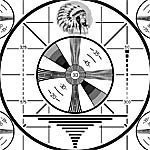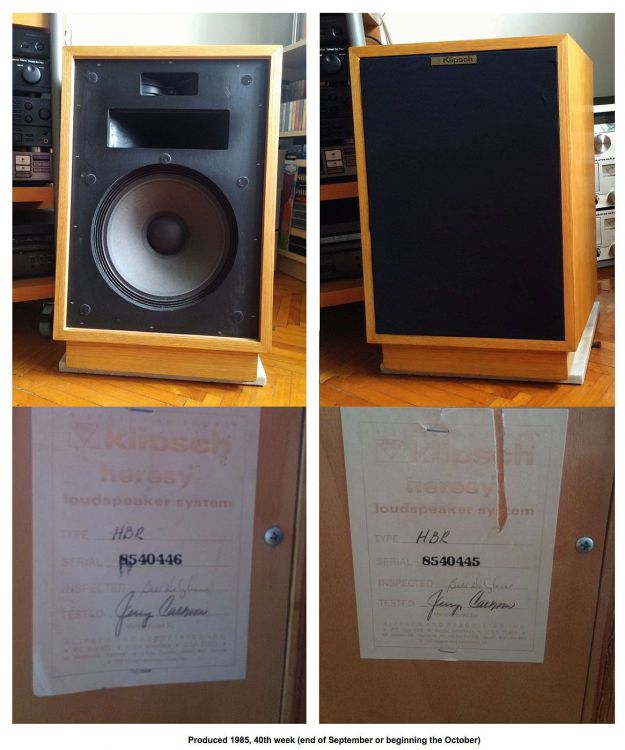-
Posts
212 -
Joined
-
Last visited
Content Type
Forums
Events
Gallery
Everything posted by Endo
-

Would like your opinion on a CL buy Heresy II...
Endo replied to Sancho Panza's topic in General Klipsch Info
Wow, that's awesome! I appreciate the thoughtful response. What are my Cornwalls made out of? They're just like the H's in the original post and also like the Nesovski H's posted above. What kind of plywood is this? Here is an image from the OP. You can see both the Fir in the core, and also the mitered construction to the cabinet. Interesting... what is that stuff. -

Would like your opinion on a CL buy Heresy II...
Endo replied to Sancho Panza's topic in General Klipsch Info
Yes, Klipsch did, I have a pair. Please bear with me, here... This was one of the points I was trying to make. Actually, Klipsch used at least 2 different types of "birch plywood" – and NOT interchangeably. The 2 kinds of birch ply seem to be used, each for different cabinet types: • The high-grade product that originates in Northern Europe (aka Baltic Birch). This is easily discerned by its uniform and alternating contrasting layers (there are 7 of these layers in the 18mm/3,4 product). Klipsch used this on the typical, unfinished, butt-rabbet-lap-jointed from first series time period. (sometimes called 'multi-ply'; if Klipsch wasn't getting it from Russia, then they were buying something comparable) • The other kind is what I've been referring to as a cabinet-grade, veneer core (likely a mixed-fir core or poplar as you've noted, as opposed to MDF core, or a hybrid core). While the latter is also void-free, it does appear more irregular in the edge striations, is available faced in either rotary or plane cut – and Klipsch used this on the miter joint Birch cabinets in addition to the MDF core. They exist. Also, it appears these 2 kinds of birch ply were NOT used interchangeably–but each to its intended purpose. [ Edit ] – While it may sound like I'm itching to be contrary, I'm more motivated by the fact that these historic speakers are valuable – and anyone concerned with their care, preservation (and maybe restoration?) might find these not-so-important details of interest. If an enthusiast isn't willing to venture into absurdity once in a while, attempting to satisfy the insatiable, why bother? It just feels right. Peace. I invite correction, if I've got any of this wrong. -

Would like your opinion on a CL buy Heresy II...
Endo replied to Sancho Panza's topic in General Klipsch Info
Yes, and keep your strike-anywhere matches next to the beans. -

Would like your opinion on a CL buy Heresy II...
Endo replied to Sancho Panza's topic in General Klipsch Info
^ Thanks for the clarification! There is something about the nature of online, public forums that encourages cantankerous, ill-mannered exchanges. @HDBRbuilder Thanks, again. If I misspoke, I certainly meant no offense. I love this place! -

Would like your opinion on a CL buy Heresy II...
Endo replied to Sancho Panza's topic in General Klipsch Info
The screens look very nice – but photos can hide some things. I may be alone, but I think they look okay. If the rest checks out, and if he comes down a little in price – I'd be tempted. Seems to me that Heresys (sp. Heresies?) are bringing a little more now than they were just a couple years ago. I've been looking for a while now, and that's my impression. Agreed, six is high, but by how much?. (no signs of high water--maybe these were up off the floor?) -
I dare you to take that to the airport.
-

Would like your opinion on a CL buy Heresy II...
Endo replied to Sancho Panza's topic in General Klipsch Info
^My comment about ash wasn't directed at you – It was the original seller that described them as ash in the listing. -

Would like your opinion on a CL buy Heresy II...
Endo replied to Sancho Panza's topic in General Klipsch Info
For whatever its worth, the speaker on the right (above) actually has a version 1 label on the back with cabinets of birch plywood (in addition to my pair, and those in the OP, these are a good example of speakers that that cannot possibly exist, as Klipsch never made them); see below... I hate to think my being confused might be a source of error for someone else... This is a Heresy from 1985, with a version 1 (HBR) label––this would be late for a v.1, right?–– and, time-wise, its close to the date on the OP set... Here's the listing: http://www.nesovski.com/page_Heresy.htm [Oh, yeah... one other thing. No way in God's green earth those are ash. ] -

Would like your opinion on a CL buy Heresy II...
Endo replied to Sancho Panza's topic in General Klipsch Info
This is where I might be confused. These two examples both have HBR written on the back label. Both Heresy. Both Birch, Raw. But, different ply cores, edge treatments and different joinery. "Same" speaker. -

Would like your opinion on a CL buy Heresy II...
Endo replied to Sancho Panza's topic in General Klipsch Info
Yep. I agree. It just seemed unusual. I guess there are (were) two different kinds of 'BR' made over the years: very different from each other. -

Would like your opinion on a CL buy Heresy II...
Endo replied to Sancho Panza's topic in General Klipsch Info
Quoting myself, -->narcissistic? Anyway, this photo shows what I'm talking about: The back of the speaker uses the same birch veneer as the remaining cabinet--however, it shows the more typical "yellowing" of the birch finish... that's what I was trying to describe... Also, if you look at the damage to the corner, you can see evidence suggesting that some kind of white-wash type finish was applied after the damage occurred: The finish residue can be seen in the crannies and crevices where it collected and was not wiped off... also along the back top edge, same. The birch has been re-finished at some point. It looks good (in the photos, at least). -

Would like your opinion on a CL buy Heresy II...
Endo replied to Sancho Panza's topic in General Klipsch Info
Yeah, they've got dings... But, they look good. Very fixable, in my estimation. If they were close to me, I'd be tempted. -

Would like your opinion on a CL buy Heresy II...
Endo replied to Sancho Panza's topic in General Klipsch Info
Its a little confusing. What I meant to suggest, was that the plywood used for the cabinets has been mitered at the corners – unlike the butt-joint more typical of "BR" cabinets made from the "multi-ply" stuff. You never see walnut, oak, etc... with butt joints. The 'Birch, Raw' was often (usually?) multi-ply with butt joints. I've got some Cornwalls that are not "BR" but rather "CBLS" . Just thought something similar might be going on here, despite the label reading "BR". -

Would like your opinion on a CL buy Heresy II...
Endo replied to Sancho Panza's topic in General Klipsch Info
Confusing? The tags read "BR" for birch, raw... but, the veneer looks to be the cabinet grade stuff with mitered corners. Would these have been a special order? The lighter finish is also unusual for the species (what I mean is, it hasn't yellowed/darkened like you'd expect with a 30+ year old birch – oil or laquer). -
^ Did not know this. This is very helpful. Thank you.
-
When I bought my 1983 CW, with original B3 networks (back in April '17) – the seller measured the big white capacitors on each of the networks and they both read 67.2 microfarads (exact match). At the time, he said this was within spec (I would not know this)... we did not measure any of the other components. • Anybody know how this compares to new specs?
-
@geoff. ^ Thanks for the insights... you've shed some light on my ignorance. Since posting, I read one of Claude's Super Cornwall posts (thank you @JohnJ @ClaudeJ1) where he describes the dual-phase-plug K55s on the Belle's as removing a 9k spike that otherwise overlaps with the tweeter. This explanation might account for some of the unexpected difference in treble between the two speakers. Just a thought. That spike would explain a lot. At this point, I'm wondering if I over estimated the crossovers being the problem. Will go ahead with the caps-only; intending to keep the CWs original in other respects. Anyone have suggestions on who makes the best caps for this application? Is SonicCap among the better caps, or simply a good value?
-
[Aside: Apologies in advance if this is a dead horse... If this is addressed somewhere else in the forum, please direct me and I'll remove the post (My searches were not effective... ) ] I have 1983 Cornwalls with B3 crossovers. To my knowledge, all drivers and network components appear to be factory original. I've never had any complaints. When I bought them, these speakers were such an improvement over anything I'd had before that I never felt a need to pursue maintenance: I was very pleased with them–and quite frankly, did not want to mess with anything for fear of taking a step backwards (I was familiar with PWK's comments about 6 years and over 300 individual tests going into the first CW production model). Anyway, I recently brought home some 1982 Belle's (came with newly installed Crites 'A' – not an 'AB' variant) and have been listening to the two pair of speakers alternately. I expected the main difference to be in the bass; with mid-range and tweeter somewhat comparable (different, perhaps–but, comparable)–but this is not so. I think the CW might need help. My sense is that lots of members here have 'been there, done that' with problems like this, right? I need to do something, but can't afford to throw away money figuring out what may or may not work... I realize some practical trial-and-error is unavoidable, but where to begin: • 1. Replace caps only, then listen? or, • 2. Get the original boards diagnosed and fixed by a professional? or, • 3: Just buy new crossovers? •–––> One last thing, if I begin by replacing caps only (doing it myself) and want to buy parts directly (eg. mouser) for the purpose of getting higher quality than what's available in kit form – what would I order? I welcome suggestions. Thanks, guys.
-
^ note the chart, as written, allows for +10 db peaks.
-
I love this chart, especially PWK's description of the various sound levels. (For those interested, Dope-from-Hope (Vol.16, No. 1). I haven't heard everything there is to hear, but I've heard a lot... and I remain convinced that a properly designed and implemented horn is as-good-as-it-gets. Never confuse a bad implementation of an otherwise good idea with a bad idea. [ Thank You, PWK ]
-
^ "Heresy III fits in my IKEA console like it was custom made for it." Wow, that is remarkable–very, very nice. Not just the fit, but the height of the drivers. Klipsch dealers might sell more Heresy center channels if they also offered the IKEA cabinet... Man, that would sell!
-
I recently came across a recording that reminded me of this post. Thought I would add to the list (I, too, have great admiration for the talent and production that went into Famous Blue Raincoat)... So, anyway – Alison Krauss sings a lullaby on the disc "Appalachian Journey" by Yo-Yo Ma, Edgar Meyer and Mark O'Connor (Released by Sony Classical). This song/rendition may be a sleeper (I have not found it anywhere else) – and sits exquisitely, tucked-away on this mostly instrumental album.

.jpg.7f454f5d60031f79a3d59a8e49e18270.jpg)






